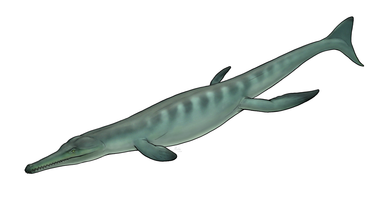Thalattosuchia
| Thalattosuchians Temporal range: Sinemurian - Early Aptian
| |
|---|---|

| |
| Platysuchus,(Teleosauridae, Teleosauroidea) | |

| |
| Cricosaurus (Metriorhynchidae, Metriorhynchoidea) | |
| Scientific classification | |
| Domain: | Eukaryota |
| Kingdom: | Animalia |
| Phylum: | Chordata |
| Class: | Reptilia |
| Clade: | Archosauria |
| Clade: | Pseudosuchia |
| Clade: | Crocodylomorpha |
| Clade: | Crocodyliformes |
| Suborder: | †Thalattosuchia Fraas, 1901[1] |
| Superfamilies | |
Thalattosuchia is a clade of marine crocodylomorphs from the Early Jurassic to the Early Cretaceous that had a cosmopolitan distribution.[3] They are colloquially referred to as marine crocodiles or sea crocodiles, though they are not members of Crocodilia and records from Thailand and China suggest that some members lived in freshwater.[4] The clade contains two major subgroupings, the Teleosauroidea and Metriorhynchoidea. Teleosauroids are not greatly specialised for oceanic life, with back osteoderms similar to other crocodyliformes. Within Metriorhynchoidea, the Metriorhynchidae displayed extreme adaptions for life in the open ocean, including the transformation of limbs into flippers, the development of a tail fluke, and smooth, scaleless skin.[5]
Discovery and naming
The term Thalattosuchia was coined by Fraas in 1901.[1] Various authors considered Thalattosuchia an infraorder or a suborder within "Mesosuchia". However, the term "Mesosuchia" is a paraphyletic group, and as such is no longer used. For consistency, the Thalattosuchia are here placed at suborder rank, although the order that contains it is unnamed. The exact phylogenetic position of Thalattosuchia is uncertain, with them either being interpreted as members of Neosuchia or basal members of Crocodylomorpha, with the similarities to neosuchians possibly being due to convergence.[6] Since Buffetaut (1982) demonstrated the shared characteristics of the early forms of Metriorhynchidae and Teleosauridae, Thalattosuchia has consisted of these two families.[7]
The oldest records of thalattosuchians date to the Sinemurian and Pliensbachian stages, represented by indeterminate remains from Argentina, Chile, and India.[8] The latest records date to the Early Cretaceous.[9] Some of the early members of Teleosauridae have been discovered in non-marine deposits. The systematics of the genus Pelagosaurus are confused, with differencing topologies placing it as either a teleosaurid,[10] or as the sister taxon to a Teleosauridae + Metriorhynchoidea clade. Others considered Pelagosaurus to be a basal metriorhynchoid.[7]
See also
References
- ^ a b Fraas E. 1901. Die Meerkrokodile (Thalattosuchia n. g.) eine neue Sauriergruppe der Juraformation. Jahreshefte des Vereins für vaterländische Naturkunde, Württemberg 57: 409-418.
- ^ Fitzinger LJFJ. 1843. Systema Reptilium. Wien: Braumüller et Seidel, 106 pp.
- ^ "The youngest record of metriorhynchid crocodylomorphs, with implications for the extinction of Thalattosuchia". Cretaceous Research. 56: 608–616. 2015. doi:10.1016/j.cretres.2015.07.001. hdl:2318/1537833.
{{cite journal}}: Unknown parameter|authors=ignored (help) - ^ Martin, Jeremy E.; Suteethorn, S.; Lauprasert, K. (February 2019). "A new freshwater teleosaurid from the Jurassic of northeastern Thailand" (PDF). Journal of Vertebrate Paleontology. 64 (2): 239–260. doi:10.1080/02724634.2018.1549059. S2CID 91988192.
- ^ Spindler, Frederik; Lauer, René; Tischlinger, Helmut; Mäuser, Matthias (2021-07-05). "The integument of pelagic crocodylomorphs (Thalattosuchia: Metriorhynchidae)". Palaeontologia Electronica. 24 (2): 1–41. doi:10.26879/1099. ISSN 1094-8074.
- ^ Wilberg, Eric W. (2015-07-01). "What's in an Outgroup? The Impact of Outgroup Choice on the Phylogenetic Position of Thalattosuchia (Crocodylomorpha) and the Origin of Crocodyliformes". Systematic Biology. 64 (4): 621–637. doi:10.1093/sysbio/syv020. ISSN 1076-836X. PMID 25840332.
- ^ a b Buffetaut, E. 1982. Radiation évolutive, paléoécologie et biogéographie des Crocodiliens mésosuchienes. Mémoires Societé Geologique de France 142: 1–88.
- ^ Bardet, N.; Falconnet, J.; Fischer, V.; Houssaye, A.; Jouve, S.; Pereda Suberbiola, X.; Pérez-García, A.; Rage, J.-C.; Vincent, P. (November 2014). "Mesozoic marine reptile palaeobiogeography in response to drifting plates". Gondwana Research. 26 (3–4): 869–887. Bibcode:2014GondR..26..869B. doi:10.1016/j.gr.2014.05.005. ISSN 1342-937X.
- ^ Young, Mark T.; Sachs, Sven (2021-09-02). "Evidence of thalattosuchian crocodylomorphs in the Portland Stone Formation (Late Jurassic) of England, and a discussion on Cretaceous teleosauroids". Historical Biology. 33 (9): 1473–1476. doi:10.1080/08912963.2019.1709453. ISSN 0891-2963. S2CID 213426116.
- ^ Gasparini Z, Pol D, Spalletti LA. 2006. An unusual marine crocodyliform from the Jurassic-Cretaceous boundary of Patagonia. Science 311: 70-73.
Further reading
- Fraas, E. (1902). "Die Meer-Krocodilier (Thalattosuchia) des oberen Jura unter specieller Berücksichtigung von Dacosaurus und Geosaurus". Paleontographica 49: 1-72.
External links
- "Ancient ocean-going crocodiles mimicked whales and dolphins" at The Guardian, 20 Apr 2020






